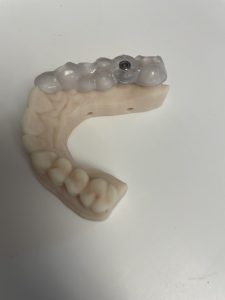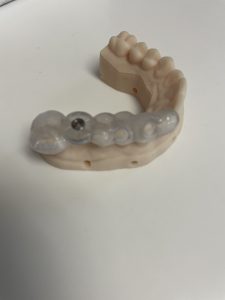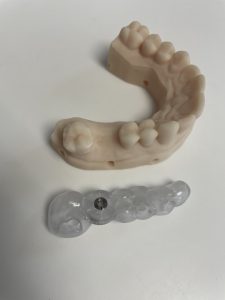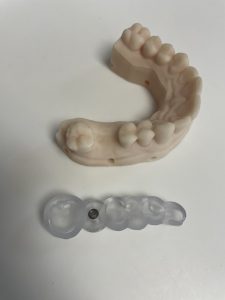Dr. Eric Block covers digitally guided implant dentistry in the following piece. Read on to see how adding guided implant dentistry could be the key to relieving stress.
I didn’t realize what had happened to me until I had hit rock bottom. I just couldn’t do it anymore. I hated my practice. I regretted dentistry. I was so afraid of getting sued, getting a bad review, or disappointing someone. Nothing I did felt right. I was totally burnt out.
At that point, I only had two options available to me. I cut my losses, leave dentistry, and work off my educational and practice debt in some other job – maybe in a cubicle situation – maybe I could go to law school so I could be the one suing. Or, I could get to the roots of my burnout, deal with the causes, and turn this mess around into something good. Gratefully, I chose the second option.
It took years but during the long climb back to getting back to enjoying dentistry, I learned a lot about burnout, what causes it, and how to avoid it. I recently pulled this hard-won wisdom into my book, The Stress-Free Dentist: Overcome Burnout and Start Loving Dentistry Again[1]. I don’t want any other dentist to have to go through what I did. But if they are, then I have a few encouraging words for you because trust me I’ve been there and back. YOU CAN DO THIS.
You can stop burnout before it stops you, and this book is chock full of information on how to do that. Once you’ve gotten past the stress and burnout, you can finally be engaged at work, at home, and actually, be happy with your profession.

There are many reasons why dentists get burned out. Some of the big ones are
- The overwhelming amount of debt or overhead
- Lack of HR and business training
- The day-to-day exhausting nature of the profession
It’s important to remember to not give in to the false belief that dentistry is just a stressful profession and there is nothing you can do, or that this is the profession I chose and I’ll just have to deal with the stress until I retire. No. This is no way to live and this mentality is unsustainable for a 40-year career.
There are concrete steps you can take to relieve pressure in these areas. For instance, one way to conquer this false belief is to invest in yourself, learn to deliver a new treatment or technology, and introduce it into your practice. Adding these new modalities, especially high-value services such as guided Implantology (implant dentistry), 3-D printing, impression-less digital scanners, clear aligners, and/or sleep apnea and airway treatments can create what I call the three R’s: Return on investment, Re-energize your staff, and practice, and Reinvent yourself.
5-PART SERIES
This will be the first of a five-part series focusing on how dentists can rejuvenate their careers and overcome or avoid burnout by adding some of these high-value treatments and technologies.
For this installment, we’ll focus on adding digital planning and guided implant dentistry.

Adding implants to your practice can feel like a daunting task, especially if you have minimal or no experience with them. It doesn’t have to be that way. Especially if you are digitally planning your cases and using surgical stents and fully-guided implant surgery. If you get the proper training and onboard your staff and take things slow with proper case selection, it can be a rewarding game changer for you and your practice.
BETTER-THAN-EXPECTED STRESS RELIEF
Digital plans and fully guided surgery systems are a technology that I, my staff, and my patients love because the surgeries are quicker, more accurate, predictable, and it causes less overall stress. Less-stressed patients relieve my stress as well. Better for me, better for the staff, and of course, better for the patient. Its win-win-win.
THE END GAME IN MIND
I have a predictable digital workflow for my implant cases. I mark any vital anatomy and merge my CBCT with the corresponding impression or scan, I virtually plan my cases in implant dentistry by starting with the crown or prosthesis first. I essentially work backwards, starting with the end restoration in mind. I then place the implant into the digital plan. From there I can customize the case.
Sometimes I have to completely change my treatment plan.
The important thing is that I have essentially performed the surgery and placed the restoration on my computer before I have even touched the patient. This typically creates a predictable surgery and ultimately excellent prosthetic result. It’s important to remember that the patient is not in your chair to get an implant. They are there to replace their missing tooth or teeth with an esthetically functioning crown or prosthesis.
This backward planning will also show you if there are going to be prosthetic challenges that you and the patient need to know about. Planning backwards will help you avoid mistakes and complications, reduce stress, and create a collaborative experience with the patient.
It may also turn out to be a case that you don’t feel comfortable working on.
TAKE IT SLOW
As you do more cases, you will get more confident and competent, and your case numbers and acceptance rate will go up. It becomes a domino effect that the entire practice can feel. Make no mistake, though, the digital plan and guided surgery are only as good as your brain and the surgical and restorative execution of the implant. A race car doesn’t drive itself. There has to be a skilled driver with a well-planned strategy to win the race. I highly recommend you start with simple cases.
Patient selection and case selection in the early learning phase are critical. Know your anatomy and your limitations. Don’t stray out of your comfort zone. For example, starting your journey into implant dentistry by replacing a central incisor, in close proximity to a sinus or nerve, an area deficient in bone, or by attempting an immediate placement can get you into trouble and ruin your confidence. Start with a molar or premolar with lots of bone and on an easy to work on patient.




GREAT FOR MARKETING AND GETTING PATIENTS TO SAY YES
There’s nothing more frustrating than when you invest in some technology or just learn a new technique and you can’t get patients to move forward with treatment. Well, during the initial implant consultation, I explained my entire digital workflow for placing and restoring implants. I will explain how I will take a CBCT of their jaw and an intra-oral scan of their teeth and merge them together in an implant planning software.

I will then virtually place the crown for future tooth position and then place and adjust my implant. From there, I export the case and 3D print a surgical guide. The patients can sense my passion and are typically impressed with the technology that it becomes easier for them to accept and move forward with treatment. After successful and efficient treatment, they are very inclined to post on social media and tell their friends and family all about it.
ENJOY GOING TO WORK EVERY DAY
Life is too short to dread going to work every day. For me taking things slow, not straying out of my comfort zone when adding digital planning and guided implant surgery to my practice has decreased those Sunday night blues. Now implant dentistry is one of the least stressful, more enjoyable, and financially rewarding treatments I provide on a weekly basis.
For me, being able to control my stress levels by making choices and having a positive impact on patients has relieved my burnout. If you can feel yourself losing joy in dentistry and wishing you could change your past, there’s hope.
Find some tools that make you happy and expand your practice and your options. Dentistry is a great life once you find your groove, but it can take a while to get there. With new treatment modalities and keeping up with the latest technology, you can start loving your job again.

ABOUT THE AUTHOR
Dr. Eric Block is a full-time practicing dentist in Acton, Massachusetts, husband, and father of two kids. He is on a mission to help dental professionals across the country overcome burnout and anxiety.
He authored his first book titled “The stress-free dentist: Overcome burnout and start loving dentistry again.”

He is the founder and CEO of the marketplace website called DealsforDentists.com, which helps dentists save time and money by helping them find new customer offers from companies across the industry.
He also interviews dentists and vendors on the Deals for Dentists Podcast and can be reached at info@dealsfordentists.com or info@thestressfreedentist.com.



